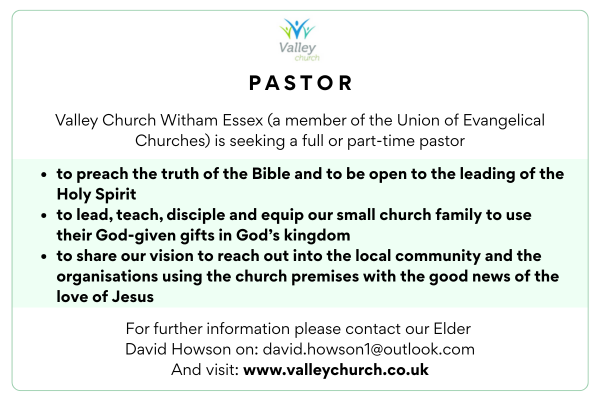The church on earth
Last month we began to look at the biblical theology of the local church. We saw that there is a real correlation between the characteristics of the church in her glorified state and the local church in this age. In this article I want to examine some of these characteristics more closely and see how they can be made real in our own local church situations.
Spiritual life
The descriptions of Eden and of the new Jerusalem include images of a tree, water and fruit which together speak of life. In the midst of Eden stood the tree of life; and in the new Jerusalem, flowing from the very throne of God, is the river of the water of life. These images still apply today.
Speaking of the Holy Spirit, Jesus said that ‘rivers of living water’ would flow from the believer’s heart. The local church, then, is a community of people in whom is life – the life of God imparted by the Spirit. A lively church is not necessarily one with lively music and gifted leadership, but one composed of people who are themselves filled with the Spirit – who are truly alive.
We will recognise such a church not by its style of worship but by its quality of life. In the new Jerusalem the tree of life yields fruit month by month. Life brings forth fruit – ‘the fruit of the Spirit [which] is love, joy, peace, patience, kindness, goodness, faithfulness, gentleness, self-control’ (Galatians 6:22-23). Is this Spirit-given life evident in our local churches?
The lively church may be small; it may meet in an old-fashioned building; its music may not be special; but it is a church in which there is real love and care.
This may not be obvious at first sight. It emerges during the week, as the sick and elderly are visited and their practical needs met; as members communicate with one another; as sacrifices are made to support the pastor and his family; and in 1001 other small ways.
Life will also be evident in the meetings of the church – in the joy and the peace which permeates the services and finds a climax in the preaching. There will be a deep-felt, God-given sense of sins forgiven, consciences cleansed and confidence in a sovereign and gracious God.
The local church, then, is a place of life.
Righteousness
As righteousness dwells in the new heavens and the new earth (2 Peter 3:13) so also the local church should be a place of righteousness. Nothing unclean, detestable or false will be found in the new Jerusalem (Revelation 22:15) and they should have no place among God’s people now.
This is much neglected at the present time. God’s people have always been subject to God’s law, from Adam onwards. The righteousness of those who follow Jesus Christ is to exceed that of the law-observing scribes and Pharisees (Matthew 5:20). Only those who keep Jesus’ commandments abide in his love and are his friends (John 15:10, 14).
We are not to steal or indulge in falsehood, anger, bitterness or corrupting talk (Ephesians 4:25-32). We are, says Peter, to be holy in all our conduct, because our God is holy (1 Peter 1:15-16).
Let us be quite clear. These passages do not refer primarily to the imputation of Christ’s righteousness to the believer but to the way believers live out their lives. Our justification by faith in Christ alone is foundational to this. It is by his merit alone, not ours, that we stand justified and accepted before God. But the Scripture insists that having been saved by faith alone in Christ alone, the believer goes on to live a new life. Being born again and with hearts that have been purified through the blood of Christ, we are to love one another earnestly, putting away all malice, deceit, hypocrisy, envy and slander (1 Peter 1:22-2:1).
There are churches where brethren have not spoken to one another for years. Churches cannot be righteous if there is strife and faction; if un-reconciled brethren attend church week after week, singing heartily of the redeeming love of God, yet all the time forgetting Paul’s admonition, ‘as the Lord has forgiven you, so you also must forgive’ (Colossians 3:13).
The community of Jesus Christ is to be a righteous community: a community of love, forgiveness, humility; a place of truth and honesty; an environment in which sexual immorality, unclean talk, wrath, malice, slander and envy are absent.
We are really to live godly, pure and holy lives, knowing that none of this will add to the salvation that Christ has accomplished for us, but knowing also that there is no other way for the children of God to live.
The church, then, is to be a community of life and of righteousness.
Evangelism
Thirdly, the church is to be an outward-looking community. We are not here simply to wait for heaven, nor are churches only places for the edification and fellowship of the saints. The New Testament sees the gospel spreading beyond the land of Israel, throughout Asia into Europe and the very heart of the Roman empire. The entire outlook is progressive, developing, growing.
A refrain in Acts is the statement that ‘the word of God continued to increase’, or ‘the word of God increased and multiplied’. These people were not constantly looking at themselves, wondering what shade of blue to choose for the new carpet. Like William Carey centuries later, they understood something of the greatness and grandeur of the commission to ‘go … and make disciples of all nations’.
John saw in heaven ‘a great multitude, from every nation, from all tribes and peoples and languages, standing before the throne and before the Lamb, clothed in white robes … crying out with a loud voice, “Salvation belongs to our God who sits on the throne, and to the Lamb!”’ (Revelation 7:9-10).
But it is in our era that this multitude must be gathered in, and it is the church’s responsibility to see that this happens. In the providence of God, we have in Britain representatives from practically every nation on our very doorstep. What a glorious opportunity to obey our Lord’s great command, to reach every nation with the gospel!
Christ centredness
The final characteristic of the church is the centrality of the Lord Jesus Christ himself. The Book of Revelation shows him at the centre of God’s purposes as their Saviour, their Lord, their Priest, their King. He rules among them and they obey him gladly. He hears their prayers and answers them. He is, supremely, the bridegroom for whom the bride is prepared.
And, of course, this is true of all New Testament teaching on the church. If we are elect, we are elect in Christ; if we are justified, it is through faith in Christ; if we are glorified, it is in him.
We are united with Christ – he is our head and we are his body. He is our foundation and cornerstone, he walks amongst the lampstands, he watches over us and leads us as the Great Shepherd of the sheep. He is our all in all.
This sense of Christ’s centrality should permeate the meetings of each local church. Our hymns must focus on the person and work of our great Saviour. Our prayers are offered to God through him – we come boldly to the throne of grace because our Saviour has lived and died for us.
Our preaching ought specially to focus on Christ, knowing nothing among us save Jesus Christ and him crucified. We do not want our pulpits to expound politics, social justice, economic truths and environmental dilemmas – important though these things may be in their place. We don’t want sermons based on pop-psychology or morality tales.
We want to hear of our Saviour – of all that he is and has done, and what that means for us. This is not a recipe for boring repetitive sermons. The whole of Scripture speaks of Christ – and look at its variety and depth!
It speaks of sin and its consequences and of salvation and its glory. It dwells on Christ’s election, incarnation, compassion, atonement, resurrection, intercession, reconciliation and redemption. And it delineates how we should live as a result of our salvation, emphasises the confidence we may have in our Saviour in this troubled world, and points to the hope we have of glory to come.
No preacher who focuses on such themes will ever be boring.
Robert Strivens
A further abridged extract from Robert Strivens’ inaugural lecture as Principal of London Theological Seminary, delivered on 14 October 2008. The full lecture is accessible at http://www.ltslondon.org








